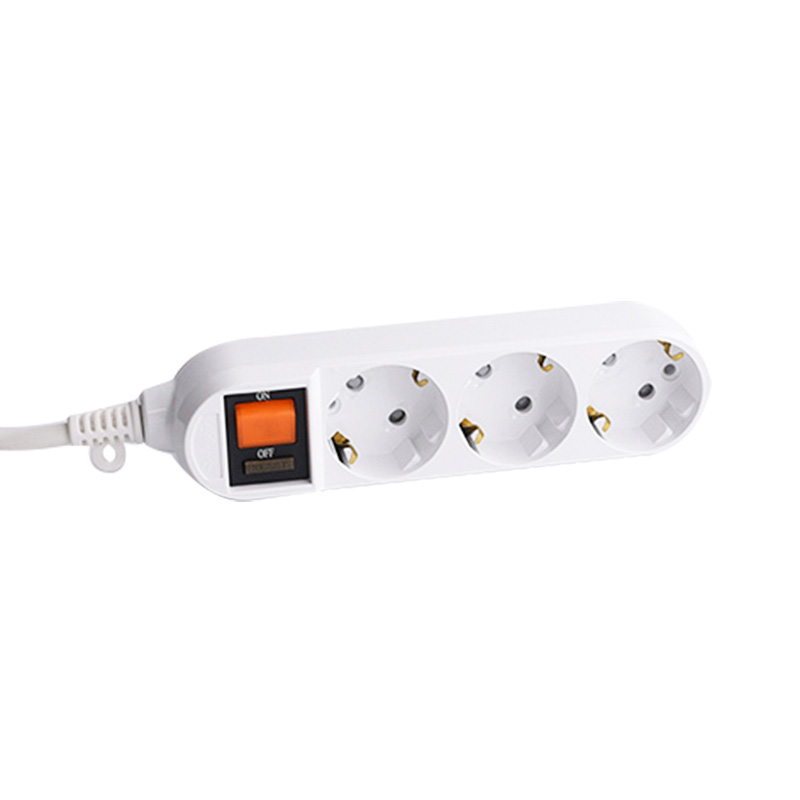Submit feedback
In a high temperature and high humidity environment, can the PC material power strip still maintain good insulation performance?
 2025.04.03
2025.04.03
 Industry News
Industry News
Whether PC material power strip/product/power-strip/pc-material-power-strip/ can maintain good insulation performance in high temperature and high humidity environment depends on multiple factors, including the characteristics of the material itself, the specific parameters of environmental conditions, and the design and manufacturing quality of the product. The following is a detailed analysis of this issue:
1. Basic characteristics of PC material
Polycarbonate (PC) is a high-performance engineering plastic with the following advantages:
Excellent mechanical strength: PC material has high impact resistance and toughness.
Good heat resistance: The glass transition temperature of PC material is usually between 140°C and 150°C, and it can withstand higher temperatures for a short time.
Some moisture resistance: PC material itself has low absorption of moisture, but it may still be affected to a certain extent in a high humidity environment.
However, PC material may experience performance degradation under extreme conditions (such as high temperature and high humidity), as shown below:
Performance changes caused by hygroscopicity: Although PC material has a low moisture absorption rate (usually in the range of 0.15%~0.2%), it may absorb trace amounts of moisture when exposed to high humidity for a long time, resulting in a decrease in its electrical insulation performance.
High temperature accelerates aging: Under high temperature conditions, PC materials may undergo thermal aging, causing the material to become brittle or surface performance to deteriorate.
2. Effects of high temperature and high humidity on insulation performance
High temperature and high humidity environments may have the following effects on the insulation performance of PC materials:
Degradation of dielectric properties: The dielectric constant and dielectric loss tangent of the insulating material may increase due to moisture absorption, thereby reducing its insulation performance.
Increase in surface leakage current: High humidity environments may cause a layer of water film to form on the surface of PC materials, increasing the risk of leakage current.
Decrease in long-term reliability: If the high temperature and high humidity environment lasts for a long time, the aging rate of PC materials will accelerate, which may cause cracks, deformation or other physical damage, further affecting the insulation performance.
3. Improvement measures in actual applications
In order to ensure that the power sockets of PC materials still maintain good insulation performance in high temperature and high humidity environments, manufacturers usually take the following measures:

Adding flame retardants and stabilizers: By adding modifiers such as flame retardants and antioxidants, the heat resistance and anti-aging ability of PC materials are improved.
Surface treatment: By applying a surface coating to the PC material (such as applying a waterproof coating), the effect of moisture on its surface is reduced.
Sealed design: Use a sealed design or moisture-proof structure to prevent moisture from entering the internal circuit.
Choose a suitable material combination: In some cases, PC materials may be combined with other materials with stronger moisture resistance (such as PBT) to improve overall performance.
4. The impact of specific environmental conditions
The specific parameters of high temperature and high humidity environments (such as temperature range, humidity level, duration) are crucial to the performance of PC materials:
If the ambient temperature is lower than the glass transition temperature of the PC material (usually 140°C~150°C) and the humidity is within a reasonable range (such as below 85% RH), PC materials can usually maintain good insulation performance.
If the ambient temperature approaches or exceeds the heat resistance limit of the PC material, or the humidity is extremely high (such as above 95% RH), its insulation performance may be significantly reduced.
Whether the power socket made of PC material can maintain good insulation performance in a high temperature and high humidity environment mainly depends on the following points:
Material quality and modification: After proper modification, high-quality PC materials can resist the influence of high temperature and high humidity to a certain extent.
Specific parameters of environmental conditions: If the temperature and humidity exceed the tolerance range of PC materials, their performance may deteriorate.
Product design and manufacturing process: Good sealing design and moisture-proof measures can significantly improve the reliability of products.
Therefore, if you need to use a power socket made of PC material in a high temperature and high humidity environment, it is recommended to choose a certified product and confirm that it complies with relevant standards (such as UL, IEC, etc.). In addition, regular inspection and maintenance of equipment to avoid long-term exposure to extreme environments are also important measures to ensure safety.
 TOP
TOP
 ENG
ENG
 English
English русский
русский 한국어
한국어 Deutsch
Deutsch









